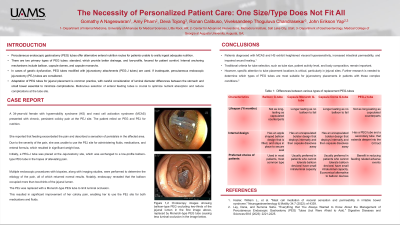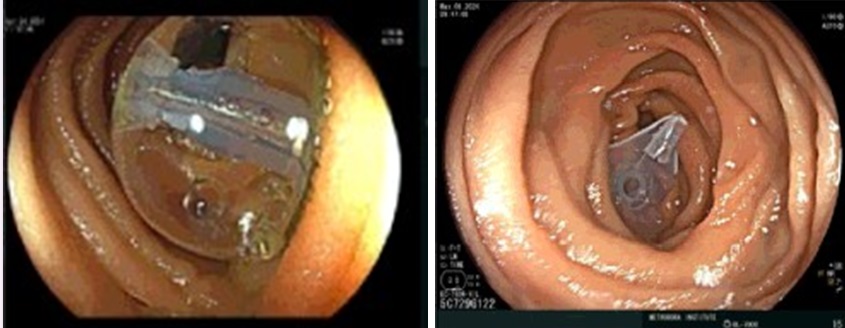Tuesday Poster Session
Category: Small Intestine
P5016 - The Necessity of Personalized Patient Care: One Size/Type Does Not Fit All
Tuesday, October 29, 2024
10:30 AM - 4:00 PM ET
Location: Exhibit Hall E

Has Audio

Gomathy A. Nageswaran, MBBS
University of Arkansas for Medical Sciences
Little Rock, AR
Presenting Author(s)
Gomathy A. Nageswaran, MBBS1, Amy Pham, BS, RD2, Deva Christine T. Tojong, MD3, Ronan Calibuso, MD4, Viveksandeep Thoguluva Chandrasekar, MD3, John Erikson Yap, MD, MBA, FACG2
1University of Arkansas for Medical Sciences, Little Rock, AR; 2Metrodora Institute, West Valley City, UT; 3Medical College of Georgia at Augusta University, Augusta, GA; 4Jersey City, NJ
Introduction: Percutaneous endoscopic gastrostomy (PEG) tubes offer alternative enteral nutrition routes for patients unable to orally ingest adequate nutrition. There are two primary types of PEG tubes: standard, which provide better drainage, and low-profile, favored for patient comfort. Internal anchoring mechanisms include balloon, capsule domes, and capsule monarchs. In cases of gastric dysfunction, PEG tubes modified with jejunostomy attachments (PEG-J tubes) are used. If inadequate, percutaneous endoscopic jejunostomy (PEJ) tubes are considered. Adaptation of PEG tubes for jejunal placement is common practice, with careful consideration of luminal diameter differences between the stomach and small bowel essential to minimize complications
Case Description/Methods: 34-year-old female with hypermobility syndrome (HS) and mast cell activation syndrome (MCAS) presents with chronic, persistent colicky pain at the PEJ site. The patient relies on PEG and PEJ for nutrition. She reports that feeding exacerbates the pain and describes a sensation of peristalsis in the affected area. Due to the severity of the pain, she is unable to use the PEJ site for administering fluids, medications, and enteral formula, which resulted in significant weight loss.
Initially, a PEG-J tube was placed at the Jejunostomy site, which was exchanged to a low-profile balloon-type PEG tube in the hopes of alleviating pain. Multiple endoscopic procedures with biopsies, along with imaging studies, were performed to determine the etiology of the pain, all of which returned normal results. Notably, endoscopy revealed that the balloon occupied more than two-thirds of the jejunal lumen. The PEJ was replaced with a Monarch-type PEG tube to limit luminal occlusion. This resulted in significant improvement of her colicky pain, enabling her to use the PEJ site for both medications and fluids.
Discussion:
Patients diagnosed with MCAS and HS exhibit heightened visceral hypersensitivity, increased intestinal permeability, and impaired wound healing. Meticulous selection of enteral feeding tubes is crucial to optimize nutrient absorption and reduce complications at the tube site. Traditional criteria for tube selection, such as tube size, patient activity level, and body composition, remain important. However, specific attention to tube placement locations is critical, particularly in jejunal sites. Further research is needed to determine which types of PEG tubes are most suitable for jejunostomy placements in patients with these complex conditions.

Note: The table for this abstract can be viewed in the ePoster Gallery section of the ACG 2024 ePoster Site or in The American Journal of Gastroenterology's abstract supplement issue, both of which will be available starting October 27, 2024.
Disclosures:
Gomathy A. Nageswaran, MBBS1, Amy Pham, BS, RD2, Deva Christine T. Tojong, MD3, Ronan Calibuso, MD4, Viveksandeep Thoguluva Chandrasekar, MD3, John Erikson Yap, MD, MBA, FACG2. P5016 - The Necessity of Personalized Patient Care: One Size/Type Does Not Fit All, ACG 2024 Annual Scientific Meeting Abstracts. Philadelphia, PA: American College of Gastroenterology.
1University of Arkansas for Medical Sciences, Little Rock, AR; 2Metrodora Institute, West Valley City, UT; 3Medical College of Georgia at Augusta University, Augusta, GA; 4Jersey City, NJ
Introduction: Percutaneous endoscopic gastrostomy (PEG) tubes offer alternative enteral nutrition routes for patients unable to orally ingest adequate nutrition. There are two primary types of PEG tubes: standard, which provide better drainage, and low-profile, favored for patient comfort. Internal anchoring mechanisms include balloon, capsule domes, and capsule monarchs. In cases of gastric dysfunction, PEG tubes modified with jejunostomy attachments (PEG-J tubes) are used. If inadequate, percutaneous endoscopic jejunostomy (PEJ) tubes are considered. Adaptation of PEG tubes for jejunal placement is common practice, with careful consideration of luminal diameter differences between the stomach and small bowel essential to minimize complications
Case Description/Methods: 34-year-old female with hypermobility syndrome (HS) and mast cell activation syndrome (MCAS) presents with chronic, persistent colicky pain at the PEJ site. The patient relies on PEG and PEJ for nutrition. She reports that feeding exacerbates the pain and describes a sensation of peristalsis in the affected area. Due to the severity of the pain, she is unable to use the PEJ site for administering fluids, medications, and enteral formula, which resulted in significant weight loss.
Initially, a PEG-J tube was placed at the Jejunostomy site, which was exchanged to a low-profile balloon-type PEG tube in the hopes of alleviating pain. Multiple endoscopic procedures with biopsies, along with imaging studies, were performed to determine the etiology of the pain, all of which returned normal results. Notably, endoscopy revealed that the balloon occupied more than two-thirds of the jejunal lumen. The PEJ was replaced with a Monarch-type PEG tube to limit luminal occlusion. This resulted in significant improvement of her colicky pain, enabling her to use the PEJ site for both medications and fluids.
Discussion:
Patients diagnosed with MCAS and HS exhibit heightened visceral hypersensitivity, increased intestinal permeability, and impaired wound healing. Meticulous selection of enteral feeding tubes is crucial to optimize nutrient absorption and reduce complications at the tube site. Traditional criteria for tube selection, such as tube size, patient activity level, and body composition, remain important. However, specific attention to tube placement locations is critical, particularly in jejunal sites. Further research is needed to determine which types of PEG tubes are most suitable for jejunostomy placements in patients with these complex conditions.

Figure: Endoscopy images showing balloon-type PEG occluding two-thirds of the jejunal lumen in the first image on the left, replaced by Monarch-type PEG tube causing less luminal occlusion in the image on the right.
Note: The table for this abstract can be viewed in the ePoster Gallery section of the ACG 2024 ePoster Site or in The American Journal of Gastroenterology's abstract supplement issue, both of which will be available starting October 27, 2024.
Disclosures:
Gomathy Nageswaran indicated no relevant financial relationships.
Amy Pham indicated no relevant financial relationships.
Deva Christine Tojong indicated no relevant financial relationships.
Ronan Calibuso indicated no relevant financial relationships.
Viveksandeep Thoguluva Chandrasekar indicated no relevant financial relationships.
John Erikson Yap indicated no relevant financial relationships.
Gomathy A. Nageswaran, MBBS1, Amy Pham, BS, RD2, Deva Christine T. Tojong, MD3, Ronan Calibuso, MD4, Viveksandeep Thoguluva Chandrasekar, MD3, John Erikson Yap, MD, MBA, FACG2. P5016 - The Necessity of Personalized Patient Care: One Size/Type Does Not Fit All, ACG 2024 Annual Scientific Meeting Abstracts. Philadelphia, PA: American College of Gastroenterology.
